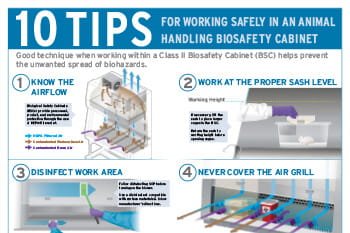
Infographic
10 Tips for Working Safely in Your Animal Handling Biosafety Cabinet
This infographic presents the top 10 tips for ensuring safety when using a NuAire Animal Handling Biosafety Cabinet (AH BSC) in your vivarium. It visually guides you through the essential protocols, ranging from understanding airflow to disinfecting your work surface. Following these straightforward tips can minimize turbulence and aerosol spread, creating a more secure and safe vivarium a
Improve safety and efficiency in your lab with these actionable tips for using a Biosafety Cabinet (BSC) during animal handling procedures. Protect personnel, animals, and the environment by following these essential practices.
Top Tips for Safe Animal Handling in a BSC
Understand the Airflow
Your Biosafety Cabinet uses HEPA-filtered air to create a protective barrier for personnel, products, and the environment. Disrupting airflow can compromise containment. Learn more about airflow dynamics in How a Class II, Type A2 Biosafety Cabinet Works.
Maintain the Proper Sash Level
Always work with the sash at the recommended height to maintain optimal airflow and safety. Adjust it only when loading large cages, and return it to its working height before starting. Read more in Biosafety Cabinet Work Access Opening Safety.
Disinfect the Work Area
Thoroughly clean and disinfect the cabinet before and after every use. Use a disinfectant compatible with the materials of your BSC to ensure surfaces remain intact and safe. Detailed steps can be found in Surface Decontamination in a Biosafety Cabinet.
Keep Air Grills Clear
Never block the front or rear air grills. Obstructions can disrupt the airflow, reduce the BSC's effectiveness, and increase contamination risks. Learn why this matters in Never Cover the Airflow Grill on a Biosafety Cabinet.
Organize Supplies Strategically
Place clean supplies on one side of the cabinet and soiled items on the other. Maintaining a designated clean and soiled area prevents cross-contamination and ensures a smoother workflow.
Handle One Cage at a Time
To minimize contamination risks, open only one cage at a time. Keep other cages closed until they are ready to be processed.
Work From Clean to Soiled
Start with clean cages and materials before handling soiled ones. This method reduces contamination risks and ensures a logical workflow.
Disinfect Gloves and Tools
Spray gloves and tools with disinfectant before use. This step is critical for maintaining sterility and preventing contamination during animal handling.
Promptly Remove Soiled Cages
Soiled cages should be removed from the Biosafety Cabinet immediately after use. Follow Standard Operating Procedures (SOPs) for handling and disposal. For more solutions, visit our Lab Animal Equipment page.
Enhance Your Safety Practices
These tips will help you maintain a safer and more efficient workspace when handling animals in your BSC. For more expert advice and solutions, explore these resources:
- Designing a Vivarium Inside and Out
- Protecting Animals and Vivarium Workers in a Rodent Facility
- Safe and Effective Research in the Vivarium
Visit our resource center for additional tips and tools to enhance your lab's safety and efficiency. Discover how this free infographic can elevate your safety and productivity.
